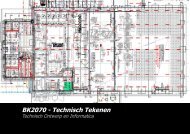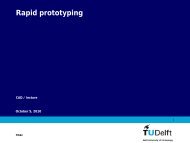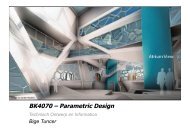esearch outside laboratories. This was the dawn of environmental psychology, <strong>in</strong> which the ma<strong>in</strong>accent was on <strong>in</strong>teractions of human be<strong>in</strong>gs with their surround<strong>in</strong>gs.Steffen (1982) dist<strong>in</strong>guishes the difference between psychology and environmental psychology.He def<strong>in</strong>es psychology as a science that systematically studies observable behavior and <strong>in</strong>visiblemental processes of an <strong>in</strong>dividual. Therefore a psychologist focuses on the behaviordeterm<strong>in</strong>ants, or <strong>in</strong> other words, on all possible factors that determ<strong>in</strong>es the perception of theenvironment. Environmental psychology, or as he also calls it, the psychology of architecture andurban plann<strong>in</strong>g, deals with behavior and mental processes of human be<strong>in</strong>gs that are related totheir spatial environment. The accent is on the built environment, which is seen as a determ<strong>in</strong><strong>in</strong>gfactor of the behavior. He def<strong>in</strong>es the whole field of environmental psychology as a study of<strong>in</strong>terrelations between psychological and spatial variables, expla<strong>in</strong><strong>in</strong>g different study areas aswell (Steffen, 1982, p. 9):1. Interior Psychology where the accent is on f<strong>in</strong>ish<strong>in</strong>g and design. For example, the effect ofcolor, light, temperature and material on comfort and pleasantness.2. Architectural Psychology where the accent is on use of build<strong>in</strong>gs, their perception, design,layout and functionality.3. Urban Psychology with the accent is on behavior on streets, <strong>in</strong> shopp<strong>in</strong>g centers or <strong>in</strong>residential areas4. Landscape Psychology, which deals with use and perception of greenery <strong>in</strong> public spaces. Forexample, parks, forests or grass-fields between apartment build<strong>in</strong>gs.Human be<strong>in</strong>gs behave and react to the environment <strong>in</strong> a certa<strong>in</strong> way. Stimulation from theenvironment and mental processes that take place concurrently, mostly sub-consciously,determ<strong>in</strong>e our behavior. Study of these processes is the doma<strong>in</strong> of Experimental Psychology.Experimental Psychology is a discipl<strong>in</strong>e that studies general human functions such as learn<strong>in</strong>g,observation, th<strong>in</strong>k<strong>in</strong>g and memory. Four ma<strong>in</strong> psychological functions are perception, cognition,emotion and motivation, which are the driv<strong>in</strong>g forces beh<strong>in</strong>d behavior. The def<strong>in</strong>ition of thesefunctions is given <strong>in</strong> the table below (Table 3), as an orientation for the reader.Table 3: def<strong>in</strong>itions of four ma<strong>in</strong> psychological functions (Steffen, 1982)four ma<strong>in</strong> areas of experimental psychologyperception is an observation process that <strong>in</strong>cludes a receipt of the <strong>in</strong>formation through senses.In such way, certa<strong>in</strong> characteristics of the surround<strong>in</strong>g are noticed, such as color or noise.cognition <strong>in</strong>cludes all learned functions such as to know, understand, th<strong>in</strong>k, judge, consider,fantasize, remember and forgetemotion considers the feel<strong>in</strong>gs <strong>in</strong> relation to the observed objects or situations or <strong>in</strong> otherwords the <strong>in</strong>ner state of affectionmotivation refers to a total of all factors that direct the behavior such as needs, aspirations,desires, <strong>in</strong>cl<strong>in</strong>ations and motivesFigure 3 expla<strong>in</strong>s the <strong>in</strong>terrelationships of spatial environment, human be<strong>in</strong>g and behavior,show<strong>in</strong>g at the same time the position of the psychological functions and their mutualdependency. On one hand, this figure <strong>in</strong>dicates the complexity of a behavior <strong>in</strong> general and thedifficulty for assess<strong>in</strong>g the behavior, s<strong>in</strong>ce the number of unknown variables is high.- 22 -
spatialenvironmenthuman be<strong>in</strong>gmental processesperceptioncognitionemotionmotivationbehaviorFigure 3: Interaction human be<strong>in</strong>g/environment/psychological functions (Steffen, 1982, p. 35)Yet what is still miss<strong>in</strong>g <strong>in</strong> the Figure 3 is the society/social context and group perception of thespatial environment. In respect to the research problem, there is a drawback of such an approachs<strong>in</strong>ce social context is not considered and the accent is on understand<strong>in</strong>g mental processes ratherthan obta<strong>in</strong><strong>in</strong>g a global <strong>in</strong>sight <strong>in</strong>to users perception of underground spaces. For this research, thegoal was to ga<strong>in</strong> more knowledge on group perception of underground stations with<strong>in</strong> a specifiedspatial environment as a part of a given social context. For those reasons, a decision was madenot to study the <strong>in</strong>dividual perception of the built environment and related mental processes, butrather to consider a wider scope and study the perception of a group <strong>in</strong> relation to the builtenvironment <strong>in</strong> a given social context. In that respect, this research belongs to sociological, ratherthan psychological study.An <strong>in</strong>terest<strong>in</strong>g view on human <strong>in</strong>formation process<strong>in</strong>g is provided by Arndt (2001), whodescribes a human be<strong>in</strong>g <strong>in</strong> a most abstract way, as a control loop that adjusts the behavior <strong>in</strong>accordance to the stimuli from the environment (Figure 4).sensoric perceptionhuman be<strong>in</strong>g'perceiver'action/reactionenvironmentFigure 4: Human be<strong>in</strong>g as a control loop, where his role is as a perceiverExtrapolat<strong>in</strong>g Figure 4 to this research and tak<strong>in</strong>g <strong>in</strong>to account the components from Figure 3,with exclusion of mental processes, a follow<strong>in</strong>g scheme can be made (Figure 5), expla<strong>in</strong><strong>in</strong>g theposition of this research. This figure shows clearly that an <strong>in</strong>terest will be taken <strong>in</strong>to group- 23 -
- Page 5: ContentsChapter 1 Introduction 11.1
- Page 9 and 10: CHAPTER 1Introduction1.1. Backgroun
- Page 11 and 12: In the Netherlands, most publicly u
- Page 13 and 14: spaces. There are also other aspect
- Page 15 and 16: The information to be processed is
- Page 17 and 18: CHAPTER 2From spatial planing to pe
- Page 19 and 20: In short, utilizing underground spa
- Page 21 and 22: Up until now it has been shown that
- Page 23 and 24: the information but also the desire
- Page 25 and 26: Another important conclusion is rel
- Page 27 and 28: develop a generic method to model t
- Page 29: In order to define the working area
- Page 33 and 34: CHAPTER 3Identification of the mode
- Page 35 and 36: case of emergency. Interestingly, t
- Page 37 and 38: judgement and experience of space.
- Page 39 and 40: Figure 4: View over the platform. U
- Page 41 and 42: •= Layout including both spatial
- Page 43 and 44: comfort seems to fulfill a biologic
- Page 45 and 46: Spatial CharacteristicsSpatial char
- Page 47 and 48: material/coloroverviewconstructione
- Page 49 and 50: Another aspect is the transparency
- Page 51 and 52: there are three key issues that are
- Page 53 and 54: •= the questions were closed, whi
- Page 55 and 56: CHAPTER 4Theoretical background on
- Page 57 and 58: some way or other has "memory". Add
- Page 59 and 60: XoWEIGHTSArtificial NeuronX1X2 Wj2.
- Page 61 and 62: Xthe inputspace(domain)inputsoutput
- Page 63 and 64: the text. This implies that general
- Page 65 and 66: numerical values. A variable is cal
- Page 67 and 68: artificial neural networks versus f
- Page 69 and 70: Figure 11: The inverse quadratic fu
- Page 71 and 72: part of the data as receptive field
- Page 73 and 74: The main feature of expert systems
- Page 75 and 76: • Use logical (deductive) reasoni
- Page 77 and 78: CHAPTER 5Experimental research: Cas
- Page 79 and 80: Figure 2: The old and new situation
- Page 81 and 82:
Figure 8, 9: Entrance to platform (
- Page 83 and 84:
Beurs/Churchillplein station is sit
- Page 85 and 86:
Figure 22, 23: The main entrance to
- Page 87 and 88:
Table 2: Aspects related to comfort
- Page 89 and 90:
5.3.3. ResponseFrom 27 May until 30
- Page 91 and 92:
7060605050404030302020Percentage100
- Page 93 and 94:
5.4.5. Way of orientingIn Figures 4
- Page 95 and 96:
Table 7: Perception of comfort in t
- Page 97 and 98:
CHAPTER 6Experimental research by k
- Page 99 and 100:
of input information i.e., the case
- Page 101 and 102:
Figure 3: Training results for rang
- Page 103 and 104:
Experiment 2aThe first 28 parameter
- Page 105 and 106:
formed by this knowledge model. In
- Page 107 and 108:
Table 4: Hierarchical order of sens
- Page 109 and 110:
Table 8: Hierarchical order of sens
- Page 111 and 112:
information structured as a knowled
- Page 113 and 114:
elationship it is understood to be
- Page 115 and 116:
10.80.60.40.201 4 7 10 13 16 19 22
- Page 117 and 118:
wilhelmina11.624.164.3wilhelmina36.
- Page 119 and 120:
wilhelmina6.720.373rijswijkblaak22.
- Page 121 and 122:
This study considered both metro an
- Page 123 and 124:
Some specific conclusions can be ma
- Page 125 and 126:
wilhelminarijswijkblaakbeurs9.62.59
- Page 127 and 128:
CHAPTER 7Conclusions and recommenda
- Page 129 and 130:
Furthermore, this research is also
- Page 131 and 132:
Additional efforts to improve knowl
- Page 133 and 134:
integrated computational intelligen
- Page 135 and 136:
Appendix A: Questionnaire for Blaak
- Page 137 and 138:
DEEL 3:HET VINDEN VAN DE WEGVraag 1
- Page 139 and 140:
DEEL 8:VERLICHTINGVraag 26: In hoev
- Page 141 and 142:
Appendix B : Learning based data an
- Page 143 and 144:
For further explanation regarding s
- Page 145 and 146:
ReferencesAlsop Architects (2001).
- Page 147 and 148:
COB (2000). Jaarverslag 1999. Centr
- Page 149 and 150:
Leonard J.A., Kramer M.A., and Unga
- Page 151 and 152:
Van Wegen, H. B. R. and Van der Voo
- Page 153 and 154:
SummaryThe intensification, combina
- Page 155 and 156:
aspects, which is derivation of dep
- Page 157 and 158:
SamenvattingBelevingsaspecten van O
- Page 159 and 160:
krachtige combinatie te zijn voor h
- Page 161 and 162:
AcknowledgmentsAfter formal discuss
- Page 163 and 164:
About the authorSanja Durmisevic wa
- Page 165 and 166:
BibliographyJournal publicationsDur
- Page 167:
Ciftcioglu Ö., Durmisevic S. and S





